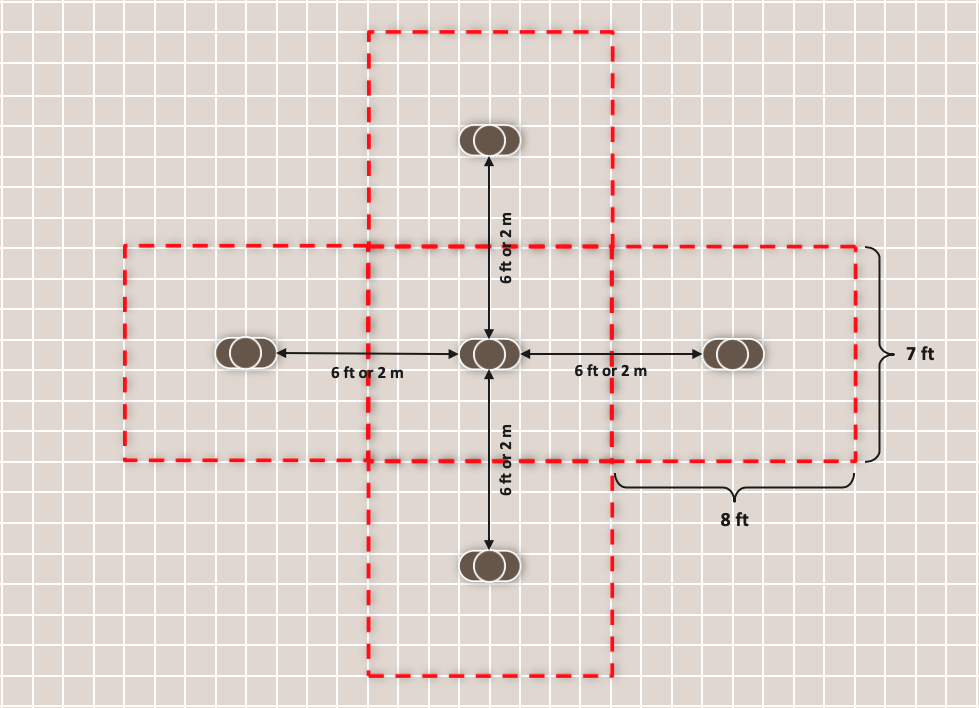Social distancing was implemented to “flatten the curve” or slow the spread of the Coronavirus to avoid the overwhelming of our healthcare systems. Social distancing flattens another curve, too: the retail sales curve. Let’s look at how this happens and its implications on staffing your stores.
While social distancing guidelines dictate that people stay 6 feet or 2 meters apart, we need to think about the floor area that a person occupies, not the distance between people, when doing space and labor planning. When thinking about area, the minimum amount of space needed for social distancing is then 7 feet by 8 feet (56 square feet) or 5.6 square meters.

However, this calculation is truly the theoretical minimum. If only allotting 56 square feet per person, one would require perfect coordination to ensure that everybody maintained their distance, which just is not practical. Instead, a buffer needs to be built into these calculations.
The good news (or bad news, depending upon your perspective) is that local and national governments will likely define how much space a retailer needs to allow per person. These restrictions will give retailers a range between 120 square feet (11 square meters) per person to 600 square feet (56 square meters) per person. For most retailers, this represents between 10 to 50 percent of a store’s maximum occupancy.
Before I go on, let me interrupt this blog post with a public service announcement: Retailers need to pay careful attention to the social distancing guidelines or occupancy restrictions that apply to them. Many of the guidelines are poorly written, some only consider the customers (not the employees), and they can vary significantly from one state to the next. In such cases, retailers need to convert square foot per customer to square foot per person.
No matter what restriction applies, one thing is clear: retailers need to limit the number of people in their stores to ensure social distancing is possible. For example, a 5,000 square foot store is limited to no more than 20 people in the store when restricted to 25 percent of its maximum occupancy which is 240 square feet per person. For most retailers, these constraints will limit peak selling hours. But, does this mean that retailers will see less sales? Not necessarily.
Essential retailers that remained open reported that their peaks were lower but average transaction values were higher. They also reported more steady traffic across the day. These retailers did have an advantage: people were willing to line up outside the door to wait for their turn to purchase groceries or pick-up a prescription. Will customers wait outside the store to buy a t-shirt or jeans? It remains to be seen.
What is obvious is that stores will support a greater mix of sales channels. While retailers need to limit the number of people in a store, foot traffic will be only one avenue to make the sale. More stores will support ecommerce fulfillment or “buy online pick up in store” and curbside pickup will make up a larger percentage of transactions than it had previously. And, depending upon the retailer, the complexion of your walk-in foot traffic may change dramatically.
From a staffing perspective, social distancing creates a trade-off between the number of customers in the store versus the number of employees in the store. The more employees needed, the fewer customers that can be present. The fewer employees working, the more customers can shop. The challenge is finding that balance especially with a new mix of sales channels and additional work required to keep your customers and employees safe and healthy.
If you need guidance about how to find the right mix of staff for your stores, how to forecast or schedule for this new sales curve, or how to properly track state-by-state or province-by-province guidelines on store occupancy, reach out to us! My email is bclements@axsiumgroup.com and I would be more than happy to arrange a free consultation for you and your team.

